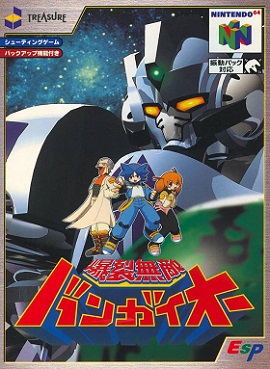
Bangai-O is a multidirectional shooter developed by Treasure and released in 1999 on the Nintendo 64 in Japan. It was ported to the Dreamcast worldwide shortly after with some gameplay changes and updated graphics and audio. The game places the player in control of a weaponized mech that can hover across large stages and fire at enemies all around them. The player must reach the end of each stage and defeat the boss, while avoiding hazards scattered across the map such as enemy mechs and gun turrets.

Star Wars: Dark Forces is a first-person shooter video game developed and published by LucasArts. It was released in 1995 for MS-DOS and Macintosh, and in 1996 for the PlayStation. The story is set in the Star Wars expanded universe and begins shortly before the original Star Wars film, before flashing forward to a year after the film's events. The game's protagonist and playable character is Kyle Katarn, a mercenary working on behalf of the Rebel Alliance who discovers the Galactic Empire's secret Dark Trooper Project, which involves the development of a series of powerful new battle droids and power-armored stormtroopers.

Einhänder is a scrolling shooter video game developed and published by Square for the PlayStation. It was released in Japan on November 20, 1997 and in North America on May 5, 1998 by Sony Computer Entertainment. It was also re-released for the Japanese PlayStation Network on June 25, 2008. The name Einhänder is German and denotes a type of sword that is wielded with one hand, here used to refer to the single manipulator arm possessed by the player's spacecraft.

Road Rash 3D is a racing video game developed and published by Electronic Arts exclusively for the PlayStation.

War Gods is a 3D fighting video game originally released to arcades by Midway Games in 1996. Ports for the Nintendo 64, PlayStation and Windows were released in 1997. In the game, players control one of ten fighters who have been given great power by a mysterious ore that crashed-landed on Earth from outer space. The object of the game is to defeat all the other fighters to become the most powerful warrior on the planet.
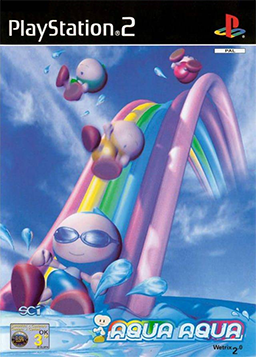
Aqua Aqua is a puzzle video game developed by Zed Two, the studio of Ste and John Pickford, for the PlayStation 2. It was published late 2000 by Imagineer in Japan, and by The 3DO Company in North America and SCi Games in Europe. It is the sequel to Wetrix (1998) and has very similar gameplay; the player, on a landscape, uses Uppers to create walls for enclosures that hold flying water bubbles, contending with hazards like rainstorms, bombs, and ice cubes in the process.
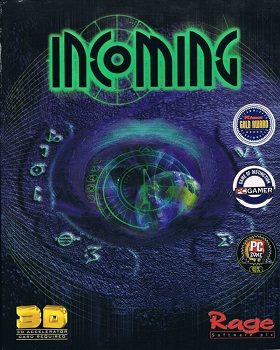
Incoming is a 3D shooter video game developed and published by Rage Software. The game was first released for Microsoft Windows in mid-1998, and was followed by a Dreamcast version, which was released in Japan on December 17, 1998, in Europe on October 14, 1999, and in North America on September 15, 1999. Set in the near-future of 2009, the game primarily revolves around controlling vehicles and turrets to fight alien invaders of Earth in one of the campaign modes, the arcade mode, and with or against another player. Some levels include brief real-time strategy segments.

Armored Core: Nexus is a 2004 third-person shooter mecha video game developed by FromSoftware for the PlayStation 2. It is the eighth entry in the Armored Core series and a sequel to 2003's Silent Line: Armored Core. Unlike Silent Line, Nexus is not an expansion but rather a full-fledged sequel.

Disruptor is a 1996 first-person shooter video game developed by Insomniac Games and published by Universal Interactive Studios for the PlayStation. It was the first game to be developed by Insomniac Games. The game was released in Europe by Interplay Productions. It received positive reviews from critics, but was a commercial failure, selling well below the company’s expectations.
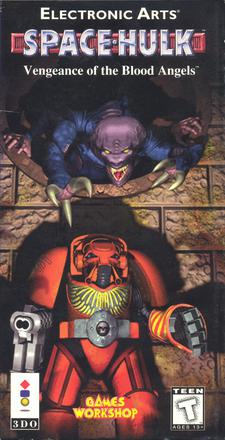
Space Hulk: Vengeance of the Blood Angels is a video game published by Electronic Arts in 1995 for the 3DO, which was later ported to PlayStation, Sega Saturn, and Microsoft Windows. It is based on Games Workshop's board game Space Hulk and is the sequel to the 1993 video game Space Hulk. Like its predecessor, Vengeance of the Blood Angels combines first-person shooter gameplay with real-time tactical elements. Space Hulk: Vengeance of the Blood Angels is part of the Warhammer 40,000 universe.

Rogue Trip: Vacation 2012, also known as Rogue Trip, is a vehicular combat video game developed by SingleTrac and published by GT Interactive for the PlayStation in 1998. The game is set in an apocalyptic fiction alternative history version of the year 2012 where mercenaries fight against each other using vehicles, and various weapons as they pick up tourists, hitchhikers, and passengers paying them fares for bringing them to vacation destinations around the remnants of the destroyed United States, and these mercenaries call themselves "auto mercenaries".
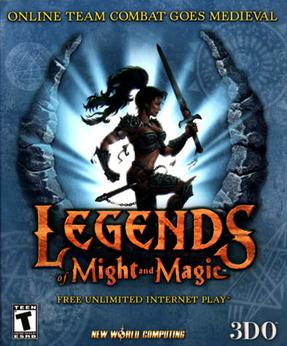
Legends of Might and Magic is a first-person shooter video game developed by Jon Van Caneghem through New World Computing and published by The 3DO Company in 2001. As a spin-off of the Might and Magic franchise, Legends has a fantasy theme. Reviews likened the game to a medieval Counter-Strike, but criticized it for being a mediocre clone.

Total Eclipse is a space flight simulation video game developed and published by Crystal Dynamics for 3DO. It was later ported to the PlayStation under the title Total Eclipse Turbo. The game was copyrighted in 1993 and released 1994. Total Eclipse Turbo was a launch title for the PlayStation in the U.S., with the game's released date predating the North American console launch by 11 days. A sequel, Solar Eclipse, was released for Sega Saturn and PlayStation.
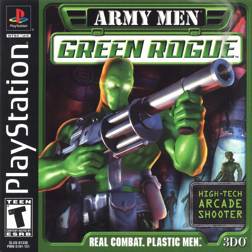
Army Men: Green Rogue is a shoot 'em up video game developed and published by The 3DO Company for PlayStation 2 and PlayStation.

Ape Escape is a 1999 platform game developed and published by Sony Computer Entertainment for the PlayStation. The first game in the Ape Escape series, the game tells the story of an ape named Specter who gains enhanced intelligence and a malevolent streak through the use of an experimental helmet. Specter produces an army of apes, which he sends through time in an attempt to rewrite history. Spike, the player character, sets out to capture the apes with the aid of special gadgets.

ReBoot is a 1998 video game developed and published by Electronic Arts for the PlayStation video game console. It is based on the television show of the same name. The story follows Bob stopping Megabyte's plan to take over Mainframe through the use of energy tears. The game's creation began in 1995, when two representatives met and agreed on the idea. EA Canada spent over the next three years going through various technological meetings during the development cycle. ReBoot garnered mixed reviews from critics who were divided over the digital control, gameplay and graphics.

Sinistar: Unleashed is a 1999 action space shooter video game for Microsoft Windows. It was designed by Marc Michalik and Walter Wright and developed at GameFX, a small studio composed of former members of Looking Glass Studios. Originally titled Out of the Void, development of the project began in 1997 and had no relationship with the Sinistar franchise. After licensing the franchise from Midway Games that year, GameFX shifted the focus of the game and developed it as a sequel to the original Sinistar, which was released by Williams in 1982.

Uprising 2: Lead and Destroy is an action/real-time strategy video game developed by Cyclone Studios and published by 3DO on December 9, 1998 for Microsoft Windows. The game is a direct sequel to Uprising which was developed and published by the same companies.

Army Men: World War - Final Front is a third-person shooter video game developed and published by The 3DO Company exclusively for PlayStation. It is the third installment in the World War subseries.

Uprising: Join or Die, also known as simply Uprising, is an action real-time strategy video game by American developer Cyclone Studios, released in North America on October 14, 1997 and in Japan on July 24, 1998 for Windows. The player controls a powerful combat vehicle known as the Wraith that transports rebel units onto the battlefield, fighting against the military. For the first few months of its development, it had no script written for it and as the release date neared, gameplay videos were created to demonstrate its support for the 3dfx graphics card. It received a port to the PlayStation as Uprising X, which was released in December 1998; and before that, a sequel, Uprising 2: Lead and Destroy, was released for the PC on December 9, 1998.


















